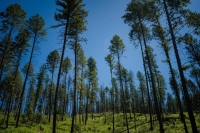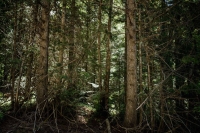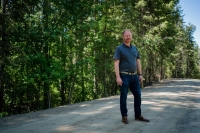Deep in Colville National Forest in eastern Washington state, Russ Vaagen is pointing to a delineation between woods that have been selectively thinned and those that haven’t. One side is light-filled and punctuated with meadows; the other is dense and dark and loaded with trees losing a Darwinian battle for water and life.
To Vaagen it’s proof that America’s sawmills and lumberjacks can help head off the forest conflagrations that are becoming ever more common, and at the same time provide the raw material for an emerging industry, known as mass timber, that makes sustainable wood building components.
Vaagen belongs to the fourth generation of a local sawmill family. In the 1980s, at the company’s peak, Vaagen Brothers Lumber ran four mills and employed 500 people. But then came a series of court decisions to protect endangered species such as the spotted owl, which greatly reduced logging on federal land in the Pacific Northwest. The Vaagens shuttered three mills and laid off hundreds. "It still stings,” Vaagen says.
While the shift preserved habitat, it didn’t make the forest healthier. The U.S. Forest Service continued to suppress all natural fires. As climate change caused hotter and drier conditions, American forests became overloaded with very flammable undergrowth. The result has been a radical rise in the size and intensity of bush fires, such as the lethal Maui fire in August and the Canadian wildfires that blanketed the East Coast in smoke in June.
Vaagen believes the U.S. must start selectively logging some smaller trees, and, better yet, he knows just what to do with them. A few years ago he sold his stake in the family mill and started a new business, Vaagen Timbers, which specializes in mass timber. The engineered wood products can be made from smaller-diameter trees, yet they’re so strong they’re being used to build towers in cities from Tokyo to Stockholm.
In a strange twist of history, Vaagen’s enthusiasm is shared by people in the very offices and organizations that once closed his family’s operation. Environmentalists and government officials see in mass timber a near-miraculous opportunity to address forest health, joblessness in rural areas and the need for low-carbon building materials all at once.
Hilary Franz, Washington’s public lands commissioner (and a Democratic candidate for governor), describes elevated forest fire risk as "an environmental crisis.” In 2017 she introduced a 20-year forestry plan that would restore over 500,000 hectares of forest by removing dead, dying and diseased trees. Ideally, that material will act as a steady supply for mass timber.
Franz sees it as a win-win-win: fire suppression, more sustainable construction and a new industry that can employ people in depressed areas. "We’re addressing the economic crisis where we have high unemployment and high underemployment in our rural areas, and we’re marrying that all up with one really beautiful solution,” she says.
Mass timber was developed in Europe a generation ago. Unlike the lumber ordinarily used to frame new buildings, its products are made of layers or strands of wood that are compressed for additional strength. Cross-laminated timber (CLT) panels, for example, are sandwiches of wood glued together at perpendicular angles.
After gaining popularity in Europe, CLT panels and glued laminated (glulam) beams and columns made their way to other parts of the world. For years, U.S. construction codes restricted their use, largely because of perceived fire risk. Recent safety testing has eased those concerns, and, after code updates, mass timber towers are rising in several U.S. cities.
Many experts say the material has a low climate footprint, since wood is a renewable resource and sequesters carbon—unlike concrete and steel, whose production emits significant amounts of carbon dioxide. Advocates say another advantage is that the buildings can be largely fabricated off-site and then assembled, for a quicker, cleaner and more efficient construction process.
"The Pacific Northwest was the first to pick it up in America, but we are on the verge of something bigger,” says Kathy Berg, a partner at ZGF Architects, whose mass timber projects include a roof for Portland International Airport and a practice facility for the San Antonio Spurs. "It is being explored in all 50 states and is one of the lowest-carbon building materials available.”
Vaagen’s personal journey to mass timber began in 2002. Despite a decade of restrictions on logging on federal land, it was clear public forests were sick. So he joined his father and a group of environmentalists in starting the Northeast Washington Forest Coalition to see if some of the deep fissures could be repaired and a new kind of forestry plan could be put in place.
From the start, Vaagen thought his role might be finding a market for dying smaller trees. Then he heard about mass timber when he was asked to supply lumber to an Oregon outfit. Intrigued, in 2016 he went to Austria to visit Hasslacher Norica Timber, a family forest products company that’s become a world leader in mass timber. He immediately saw the potential.
Soon after, he sold his stake in the family business and used the money to buy expensive equipment to start his own mass timber operation. Its low-slung, light-filled offices connect to a 70,000-square-foot factory, together employing about 100 people. The factory churns out both glulam beams, used as structural building supports, and precisely cut CLT panels, used for floors and walls.
Tom Baun, Vaagen’s senior business development manager, says that when he first started selling the products he needed to explain everything from how the material was made to how it could be used. "I felt like a door-to-door dictionary salesman,” he says.
Now people just get it, Vaagen says, and sales have been steadily rising. Customers vary from people building their own homes to institutions such as universities looking to construct statement buildings. His company is private, yet Vaagen says top-line sales grew from $10 million in 2021 to $27 million last year and should reach $40 million this year. That tracks with the overall mass timber market in the U.S., which is growing at about 30% a year, according to market research firms.
Of course, mass timber is a startup industry like any other. Equipment is expensive, and sales are uneven. Vaagen Timbers has yet to make an annual profit. Structurlam Mass Timber, a large Vancouver-based company, filed for bankruptcy in April. Mercer International, a Canadian company, purchased its assets-including an enormous facility in Spokane, Washington-and now controls about 50% of the North American market.
Nick Milestone, director of project execution for Mercer’s mass timber subsidiary, says, "There will be more supply than demand for a while.”
But there’s help on the way. The 2022 Inflation Reduction Act included $1.5 billion for forest restoration, which at least in Washington state will support logging small-diameter trees in overgrown forests. It also has $350 million to help reduce embodied carbon in the building sector, which could also juice demand for mass timber.
Connecting the nascent industry to the forest restoration part of the package is particularly important for Vaagen. Mass timber doesn’t inherently require sustainable forestry. In fact, many operations buy their raw supply from the same privately owned timber farms where the rest of the construction industry gets its two-by-fours. Although the material is less carbon-intensive than concrete, it does nothing for forest health unless it’s harvested sustainably.
To get that additional value would require selective pruning to spread to national forests, which was tested in the A to Z Forest Restoration Project, a collaboration among the Northeast Coalition, federal forest managers and a biochar company, meant as a model for holistic forestry.
What made the project unique was that the government outsourced almost everything, including the painfully time-consuming National Environmental Policy Act work of selecting which trees were to be harvested, to Vaagen Brothers Lumber. The NEPA work happened when Russ was still with his father’s company.
After reviewing the plan, the Forest Service in 2016 gave the company permission to selectively log 54,000 acres of national forest. Since clearing forests is slow work, the contract was set for 10 years. Vaagen’s mass timber operation takes the logs, and the slash left over is converted to bioenergy and biochar. Bioenergy is generated from burning the organic matter, or biomass, in the tree limbs, while biochar is the resulting ash that can be used as an ingredient in fertilizer.
Not everyone is convinced this will help with forest health. Alliance for the Wild Rockies, a Montana-based advocacy group, sued the Forest Service to stop the contract, saying it would also affect old-growth trees and some endangered species, but lost. Laurie Wayburn, president of Pacific Forest Trust, another advocacy group, says selective thinning is a needed tool but would be better paired with small fires that more closely mimic the forest’s natural cycles.
Vaagen disagrees that controlled burns are necessary at all. Millions of acres of national forest are still at high risk of being torched, according to the government’s own estimates, and management practices must evolve to keep up, he says.
The government just approved a second A to Z project, this time for 28,000-plus hectares in central Washington. Vaagen Brothers will again be the contractor, and Vaagen Timbers will buy the output and even build worker housing out of mass timber, among other things, since nothing local can fulfill the need.
"My goal is to prove this out on scale,” Vaagen says. "The goal is to reintroduce the forest infrastructure to the places where it’s gone in the Intermountain West, like Wyoming, Utah and southern Idaho, and put sawmills, biomass-to-energy and mass timber facilities all integrated to thin out the forests.”




























With your current subscription plan you can comment on stories. However, before writing your first comment, please create a display name in the Profile section of your subscriber account page.